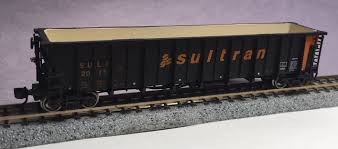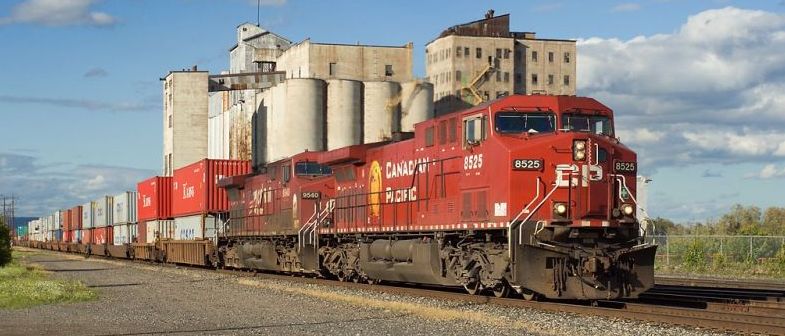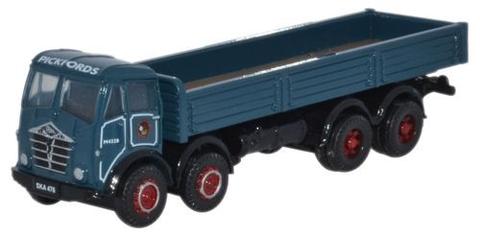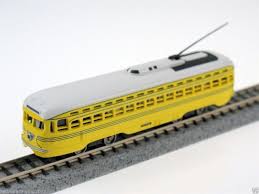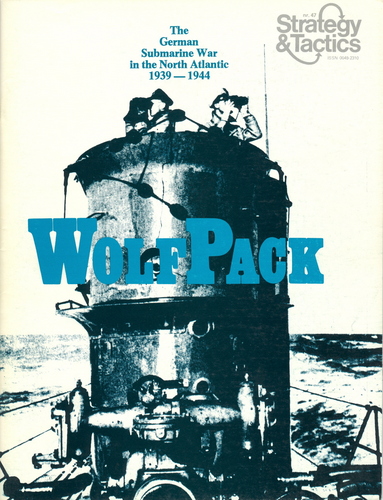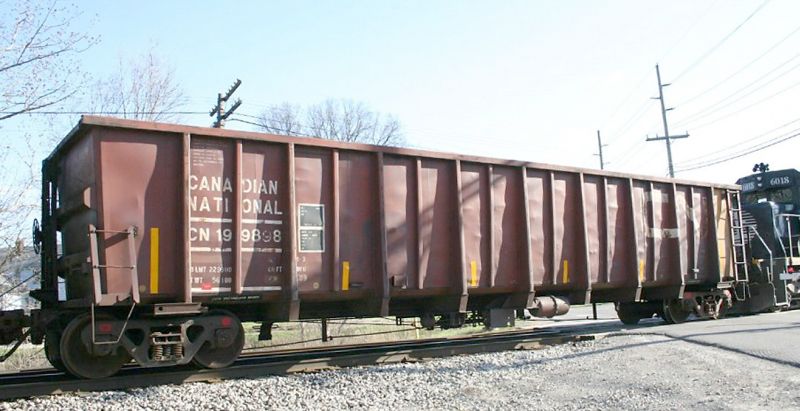Specific Item Information: 19 side posts; 3 ribs on the end with tall gusset plates, wide radius corners on the ends and a single, elongated hole on the bolster/ roping plate. The reservoir is mounted perpendicular to the car side (with a protective bar between the floor joists) and located between the 4th and 5th major side posts (type 4 underframe). Note how far below the underframe the brake rods hang - the rod connects to the truck above the axles.
Model Information: PWRS introduced this body style in 2008.
Prototype History: The 4000 cu ft. gondola was the preferred car style of CN for transporting coal from five Alberta mines to either the west coast ports for export or to ports on Lake Superior (Thunder Bay, Marmion Lake) for use by Ontario Hydro.
The first cars were built in 1970 for CN as CN 199000 series and the first eight in the series were built as double rotary cars with a rotating drawbar on each end. The cars had a capacity of 263,000 lbs and a light weight of about 58,000 lbs, giving them a load limit of approximately 205,000 lbs. Thus the cars could carry a cargo of 100 tons with a little room for overloads. When the maximum capacity was increased to 286, 000 lbs, all of the coal cars had the load limit increased by 23, 000 lbs. (The SULX cars kept their original load limit).
The cars also had a load-empty feature that increased the braking capacity of the cars when loaded, similar to a retainer. The purpose was to reduce the brake pressure when the cars were empty in order to reduce the number of skidded wheels while providing sufficient braking capacity when loaded.
From PWRS
The first cars were built in 1970 for CN as CN 199000 series and the first eight in the series were built as double rotary cars with a rotating drawbar on each end. The cars had a capacity of 263,000 lbs and a light weight of about 58,000 lbs, giving them a load limit of approximately 205,000 lbs. Thus the cars could carry a cargo of 100 tons with a little room for overloads. When the maximum capacity was increased to 286, 000 lbs, all of the coal cars had the load limit increased by 23, 000 lbs. (The SULX cars kept their original load limit).
The cars also had a load-empty feature that increased the braking capacity of the cars when loaded, similar to a retainer. The purpose was to reduce the brake pressure when the cars were empty in order to reduce the number of skidded wheels while providing sufficient braking capacity when loaded.
From PWRS
Road Name History: In the early 70's sulphur was a very abundant yet low-value commodity and there were few markets for the product in Canada. Logistics for handling and transporting the element were chaotic, costly and unreliable. Sulphur producers were frustrated by the inability to dependably and efficiently access growing world markets.
As sulphur showed signs of escalating in demand and value, it became apparent that improved methods of transporting and handling the commodity were required. These new methods had to be cost efficient, environmentally sound and offer reliability and dependability to the sulphur industry and its customers.
In September of 1974, Petrofina, Shell Canada Resources and Hudson Bay Oil & Gas became key members of an eight-member industry task force. They developed a mandate for a producer-owned, independently managed, sulphur logistics service company, incorporating the business and offering shares to all interested producers. On December 16, 1975 Sultran Ltd. was incorporated as a private company with twenty-three shareholders holding 905,000 shares.
Much of the progress Sultran has made is the direct result of the investment of capital in system improvements. From the acquisition, renovating and building of facilities and the establishment of related companies, to the continuing purchasing and upgrading of equipment allowing operations to run smoothly, Sultran and its subsidiary company, Pacific Coast Terminals have been able to achieve significant results in their industry and have positive impacts on their surrounding communities and environments.
As sulphur showed signs of escalating in demand and value, it became apparent that improved methods of transporting and handling the commodity were required. These new methods had to be cost efficient, environmentally sound and offer reliability and dependability to the sulphur industry and its customers.
In September of 1974, Petrofina, Shell Canada Resources and Hudson Bay Oil & Gas became key members of an eight-member industry task force. They developed a mandate for a producer-owned, independently managed, sulphur logistics service company, incorporating the business and offering shares to all interested producers. On December 16, 1975 Sultran Ltd. was incorporated as a private company with twenty-three shareholders holding 905,000 shares.
Much of the progress Sultran has made is the direct result of the investment of capital in system improvements. From the acquisition, renovating and building of facilities and the establishment of related companies, to the continuing purchasing and upgrading of equipment allowing operations to run smoothly, Sultran and its subsidiary company, Pacific Coast Terminals have been able to achieve significant results in their industry and have positive impacts on their surrounding communities and environments.
Brand/Importer Information: North American Railcar is a manufacturer of N Scale model rolling stock. NAR is a subsidiary of Pacific Western Rail Systems, a hobby shop based in Surrey, British Columbia, founded by owner Dan Huberman. PWRS has been working with Micro-Trains for decades producing special runs of MTL cars for sale exclusively through their store. In 2008, PWRS started production of their own body styles - which are also exclusively sold through the PWRS storefront under the brand name North American Railcar. As of 2016 they produce three body styles each with several variations to achieve prototypical accuracy. In 2017 they announced production of a fourth body style.
Item created by: gdm on 2018-11-01 18:44:53. Last edited by CNW400 on 2020-05-21 14:48:42
If you see errors or missing data in this entry, please feel free to log in and edit it. Anyone with a Gmail account can log in instantly.
If you see errors or missing data in this entry, please feel free to log in and edit it. Anyone with a Gmail account can log in instantly.


